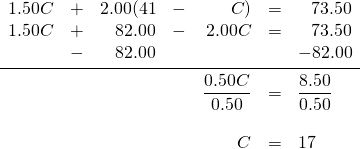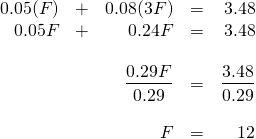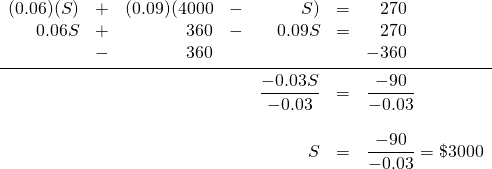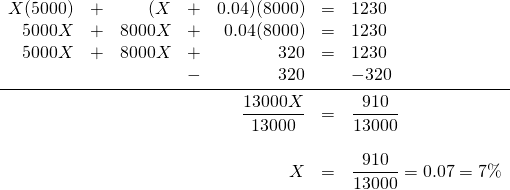Chapter 5: Systems of Equations
5.5 Monetary Word Problems
Solving value problems generally involves the solution of systems of equations. Value problems are ones in which each variable has a value attached to it, such as a nickel being worth 5¢, a dollar worth ![]() and a stamp worth 85¢. Using a table will help to set up and solve these problems. The basic structure of this table is shown below:
and a stamp worth 85¢. Using a table will help to set up and solve these problems. The basic structure of this table is shown below:
| Name | Amount | Value | Equation |
|---|---|---|---|
The first column in the table (Name) is used to identify the objects in the problem. The second column (Amount) identifies the amounts of each of the objects. The third column (Value) is used for the value of each object. The last column (Equation) is the product of the Amount times the Value.
Example 5.5.1
In Cally’s piggy bank, there are 11 coins having a value of ![]() Each coin is either a quarter or a dime. Use this data to fill in the chart and find the equation to be solved.
Each coin is either a quarter or a dime. Use this data to fill in the chart and find the equation to be solved.
- The objects’ names are quarters (Q) and dimes (D)
 which means
which means  or
or 
- Quarters have a value of
 and dimes have a value of
and dimes have a value of 
| Name | Amount | Value | Equation |
|---|---|---|---|
| Quarters (Q) | |||
| Dimes (D) | |||
| Mixture | 11 | N/A |
The first two equations generally combine to equal the third equation.
The equation derived from this data is: ![]()
Example 5.5.2
Doug and Becky sold 41 tickets for an event. Tickets for children cost ![]() and tickets for adults cost
and tickets for adults cost ![]() . Total receipts for the event were
. Total receipts for the event were ![]() How many of each type of ticket was sold?
How many of each type of ticket was sold?
| Name | Amount | Value | Equation |
|---|---|---|---|
| Children (C) | |||
| Adult (A) | |||
| Mixture | 41 | N/A |
The equation to be solved is:

This means that the number of adult tickets sold was ![]()
Example 5.5.3
Nick has a collection of 5-cent stamps and 8-cent stamps. There are three times as many 8-cent stamps as 5-cent stamps. The total value of all the stamps is ![]() How many of each stamp does Nick have?
How many of each stamp does Nick have?
| Name | Amount | Value | Equation |
|---|---|---|---|
| Five-centers (F) | |||
| Eight-centers (E) | |||
| Mixture | N/A |
The equation to be solved is:

This means that the number of eight-cent stamps is ![]()
Example 5.5.4
Angela invests ![]() in two accounts, one at 6% interest, the other at 9% interest for one year. At the end of the year, she had earned
in two accounts, one at 6% interest, the other at 9% interest for one year. At the end of the year, she had earned ![]() in interest. How much did she have invested in each account?
in interest. How much did she have invested in each account?
| Name | Amount | Value | Equation |
|---|---|---|---|
| Account (S) | 0.06 | ||
| Account (N) | 0.09 | ||
| Total interest | N/A |
The equation to be solved is:

This means that the amount in the nine-percent account is ![]()
Example 5.5.5
Clark and Kyra invest ![]() in one account and
in one account and ![]() in an account paying 4% more in interest. They earned
in an account paying 4% more in interest. They earned ![]() in interest after one year. At what rates did they invest?
in interest after one year. At what rates did they invest?
| Name | Amount | Value | Equation |
|---|---|---|---|
| Account (F) | |||
| Account (E) | |||
| Total interest | N/A | N/A |
The equation to be solved is:

The other interest rate is ![]()
This means that ![]() was invested at 7% and
was invested at 7% and ![]() was invested at 11%.
was invested at 11%.
Questions
For questions 1 to 10, find the equations that describe each problem. Do not solve.
- A collection of dimes and quarters is worth
 There are 103 coins in all. How many of each kind of coin is there?
There are 103 coins in all. How many of each kind of coin is there? - A collection of fifty-cent pieces and nickels is worth
 There are 34 coins in all. How many of each kind of coin is there?
There are 34 coins in all. How many of each kind of coin is there? - The attendance at a school concert was 578. Admission was
 for adults and
for adults and  for children. The total of the receipts was
for children. The total of the receipts was  How many adults and how many children attended?
How many adults and how many children attended? - Natasha’s purse contains
 made up of dimes and quarters. If there are 21 coins in all, how many dimes and how many quarters are there?
made up of dimes and quarters. If there are 21 coins in all, how many dimes and how many quarters are there? - A boy has
 in nickels and dimes. If there are twice as many dimes as nickels, how many of each kind of coin does he have?
in nickels and dimes. If there are twice as many dimes as nickels, how many of each kind of coin does he have?  is made up of quarters and fifty-cent pieces. If the number of quarters exceeds the number of fifty-cent pieces by three, how many coins of each denomination are there?
is made up of quarters and fifty-cent pieces. If the number of quarters exceeds the number of fifty-cent pieces by three, how many coins of each denomination are there?- An inheritance of
 is invested in two ways, part at 9.5% and the remainder at 11%. The combined annual interest was
is invested in two ways, part at 9.5% and the remainder at 11%. The combined annual interest was  How much was invested at each rate?
How much was invested at each rate? - Kerry earned a total of
 last year on his investments. If
last year on his investments. If  was invested at a certain rate of return and
was invested at a certain rate of return and  was invested in a fund with a rate that was 2% higher, find the two rates of interest.
was invested in a fund with a rate that was 2% higher, find the two rates of interest. - Jason earned
 in interest last year on his investments. If
in interest last year on his investments. If  was invested at a certain rate of return and
was invested at a certain rate of return and  was invested in a fund with a rate that was double the rate of the first fund, find the two rates of interest.
was invested in a fund with a rate that was double the rate of the first fund, find the two rates of interest. - Millicent earned
 last year in interest. If
last year in interest. If  was invested at a certain rate of return and
was invested at a certain rate of return and  was invested in a fund with a rate that was 2% lower, find the two rates of interest.
was invested in a fund with a rate that was 2% lower, find the two rates of interest.
For questions 11 to 25, find and solve the equations that describe each problem.
- There were 203 tickets sold for a volleyball game. For activity-card holders, the price was
 each, and for non-card holders, the price was
each, and for non-card holders, the price was  each. The total amount of money collected was
each. The total amount of money collected was  How many of each type of ticket was sold?
How many of each type of ticket was sold? - At a local ball game, the hot dogs sold for
 each and the hamburgers sold for
each and the hamburgers sold for  each. There were 131 total food items sold for a total value of
each. There were 131 total food items sold for a total value of  How many of each item was sold?
How many of each item was sold? - A piggy bank contains 27 total dimes and quarters. The coins have a total value of
 Find the number of dimes and quarters in the piggy bank.
Find the number of dimes and quarters in the piggy bank. - A coin purse contains 18 total nickels and dimes. The coins have a total value of
 Find the number of nickels and dimes in the coin purse.
Find the number of nickels and dimes in the coin purse. - Sally bought 40 stamps for
 The purchase included 25¢ stamps and 20¢ stamps. How many of each type of stamp was bought?
The purchase included 25¢ stamps and 20¢ stamps. How many of each type of stamp was bought? - A postal clerk sold some 15¢ stamps and some 25¢ stamps. Altogether, 15 stamps were sold for a total cost of
 How many of each type of stamp was sold?
How many of each type of stamp was sold? - A total of
 is invested, part of it at 12% and the rest at 13%. The total interest after one year is
is invested, part of it at 12% and the rest at 13%. The total interest after one year is  How much was invested at each rate?
How much was invested at each rate? - A total of
 is invested, part of it at 5% and the rest at 7.5%. The total interest after one year is
is invested, part of it at 5% and the rest at 7.5%. The total interest after one year is  How much was invested at each rate?
How much was invested at each rate? - The total value of dimes and quarters in a piggy bank is
 There are six more quarters than dimes. Find the number of each type of coin in the piggy bank.
There are six more quarters than dimes. Find the number of each type of coin in the piggy bank. - A piggy bank contains nickels and dimes. The number of dimes is ten less than twice the number of nickels. The total value of all the coins is
 Find the number of each type of coin in the piggy bank.
Find the number of each type of coin in the piggy bank. - An investment portfolio earned
 in interest last year. If
in interest last year. If  was invested at a certain rate of return and
was invested at a certain rate of return and  was invested in a fund with a rate that was 4% lower, find the two rates of interest.
was invested in a fund with a rate that was 4% lower, find the two rates of interest. - Samantha earned
 in interest last year on their investments. If
in interest last year on their investments. If  was invested at a certain rate of return and
was invested at a certain rate of return and  was invested in a fund with a rate that was two-thirds the rate of the first fund, find the two rates of interest.
was invested in a fund with a rate that was two-thirds the rate of the first fund, find the two rates of interest. - A man has
 in nickels, dimes, and quarters. There are twice as many nickels as dimes and three more dimes than quarters. How many coins of each kind are there?
in nickels, dimes, and quarters. There are twice as many nickels as dimes and three more dimes than quarters. How many coins of each kind are there? - A bag containing nickels, dimes, and quarters has a value of
 If there are 40 coins in all and three times as many dimes as quarters, how many coins of each kind are there?
If there are 40 coins in all and three times as many dimes as quarters, how many coins of each kind are there? - A collection of stamps consists of 22¢ stamps and 40¢ stamps. The number of 22¢ stamps is three more than four times the number of 40¢ stamps. The total value of the stamps is
 Find the number of 22¢ stamps in the collection.
Find the number of 22¢ stamps in the collection.

